
(a)
Interpretation:
The expected hybridization of the central an atom in
Concept Introduction:
When two atomic orbitals combine with each other to produce hybrid orbitals, redistribution of energy of orbitals of distinct an atom s to form orbitals with equal energy occurs. This process is known as hybridization and the formed new orbitals are known as hybrid orbitals.
(a)
Answer to Problem 20E
The expected hybridization of the central an atom in
Explanation of Solution
On the basis of types of orbitals involved in mixing, different hybridization is classified as sp, sp2, sp3, sp3d, sp3d2, sp3d3.
sp-hybridization: It is formed when one s and one p orbital mix with each other in same shell of an atom to produce two new equal orbitals. This hybridization takes place in linear molecules.
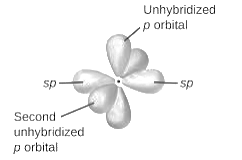
sp2-hybridization: It is formed when one s and two p orbital mix with each other in same shell of an atom to produce three new equal orbitals. This hybridization takes place in molecules exhibits trigonal planar geometry.

sp3-hybridization: It is formed when one s and three p orbital mix with each other in same shell of an atom to produce four new equal orbitals. This hybridization takes place in molecules exhibits tetrahedral geometry. In this hybridization, no p-unhybridized orbital is present as all are hybridized and form four sigma bonds.
Now, for an atom , present in the structure compound, the sum of the number of bonded an atom s and number of lone pairs present on it results its steric number. The value of steric number tells about the hybridization of central an atom .
| Steric Number | Hybridization | Structure |
| 2 | sp | Linear |
| 3 | sp2 | Trigonal Planar |
| 4 | sp3 | Tetrahedral |
| 5 | sp3d | Trigonal bipyramidal |
| 6 | sp3d2 | Octahedral |
| 7 | sp3d3 | Pentagonal bipyramidal |
In
Number of valence electrons = 8
The expression for calculating number of electron pairs is:
Where, X = number of electron pairs
V = valence electrons of central an atom
M = number of monovalent an atom s
C = charge on compound.
In
Number of lone pairs = 0
Steric number 5 shows that the hybridization of central an atom is sp3d and geometry is Trigonal bipyramidal.
(b)
Interpretation:
The expected hybridization of the central an atom in
Concept Introduction:
When two atomic orbitals combine with each other to produce hybrid orbitals, redistribution of energy of orbitals of distinct an atom s to form orbitals with equal energy occurs. This process is known as hybridization and the formed new orbitals are known as hybrid orbitals.
(b)
Answer to Problem 20E
The expected hybridization of the central an atom in
Explanation of Solution
On the basis of types of orbitals involved in mixing, different hybridization is classified as sp, sp2, sp3, sp3d, sp3d2, sp3d3.
sp-hybridization: It is formed when one s and one p orbital mix with each other in same shell of an atom to produce two new equal orbitals. This hybridization takes place in linear molecules.
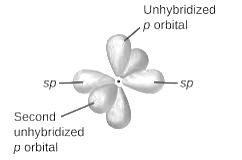
sp2-hybridization: It is formed when one s and two p orbital mix with each other in same shell of an an atom to produce three new equal orbitals. This hybridization takes place in molecules exhibits trigonal planar geometry.
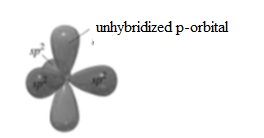
sp3-hybridization: It is formed when one s and three p orbital mix with each other in same shell of an atom to produce four new equal orbitals. This hybridization takes place in molecules exhibits tetrahedral geometry. In this hybridization, no p-unhybridized orbital is present as all are hybridized and form four sigma bonds.
Now, for an atom , present in the structure compound, the sum of the number of bonded an atom s and number of lone pairs present on it results its steric number. The value of steric number tells about the hybridization of central an atom .
| Steric Number | Hybridization | Structure |
| 2 | sp | Linear |
| 3 | sp2 | Trigonal Planar |
| 4 | sp3 | Tetrahedral |
| 5 | sp3d | Trigonal bipyramidal |
| 6 | sp3d2 | Octahedral |
| 7 | sp3d3 | Pentagonal bipyramidal |
In
Number of valence electrons = 7
The expression for calculating number of electron pairs is:
Where, X = number of electron pairs
V = valence electrons of central an atom
M = number of monovalent an atom s
C = charge on compound.
In
Number of lone pairs = 0
Steric number 5 shows that the hybridization of central an atom is sp3d and geometry is Trigonal bipyramidal.
(c)
Interpretation:
The expected hybridization of the central an atom in
Concept Introduction:
When two atomic orbitals combine with each other to produce hybrid orbitals, redistribution of energy of orbitals of distinct an atom s to form orbitals with equal energy occurs. This process is known as hybridization and the formed new orbitals are known as hybrid orbitals.
(c)
Answer to Problem 20E
The expected hybridization of the central an atom in
Explanation of Solution
On the basis of types of orbitals involved in mixing, different hybridization is classified as sp, sp2, sp3, sp3d, sp3d2, sp3d3.
sp-hybridization: It is formed when one s and one p orbital mix with each other in same shell of an an atom to produce two new equal orbitals. This hybridization takes place in linear molecules.
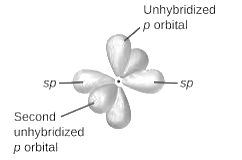
sp2-hybridization: It is formed when one s and two p orbital mix with each other in same shell of an atom to produce three new equal orbitals. This hybridization takes place in molecules exhibits trigonal planar geometry.
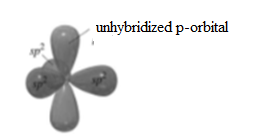
sp3-hybridization: It is formed when one s and three p orbital mix with each other in same shell of an atom to produce four new equal orbitals. This hybridization takes place in molecules exhibits tetrahedral geometry. In this hybridization, no p-unhybridized orbital is present as all are hybridized and form four sigma bonds.
Now, for an atom, present in the structure compound, the sum of the number of bonded an atom s and number of lone pairs present on it results its steric number. The value of steric number tells about the hybridization of central an atom .
| Steric Number | Hybridization | Structure |
| 2 | sp | Linear |
| 3 | sp2 | Trigonal Planar |
| 4 | sp3 | Tetrahedral |
| 5 | sp3d | Trigonal bipyramidal |
| 6 | sp3d2 | Octahedral |
| 7 | sp3d3 | Pentagonal bipyramidal |
In
Number of valence electrons = 6
The expression for calculating number of electron pairs is:
Where, X = number of electron pairs
V = valence electrons of central an atom
M = number of monovalent an atom s
C = charge on compound.
In
Number of lone pairs = 0
Steric number 5 shows that the hybridization of central an atom is sp3d and geometry is Trigonal bipyramidal.
(d)
Interpretation:
The expected hybridization of the central an atom in
Concept Introduction:
When two atomic orbitals combine with each other to produce hybrid orbitals, redistribution of energy of orbitals of distinct an atom s to form orbitals with equal energy occurs. This process is known as hybridization and the formed new orbitals are known as hybrid orbitals.
(d)
Answer to Problem 20E
The expected hybridization of the central an atom in
Explanation of Solution
On the basis of types of orbitals involved in mixing, different hybridization is classified as sp, sp2, sp3, sp3d, sp3d2, sp3d3.
sp-hybridization: It is formed when one s and one p orbital mix with each other in same shell of an an atom to produce two new equal orbitals. This hybridization takes place in linear molecules.
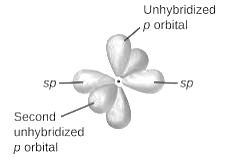
sp2-hybridization: It is formed when one s and two p orbital mix with each other in same shell of an atom to produce three new equal orbitals. This hybridization takes place in molecules exhibits trigonal planar geometry.
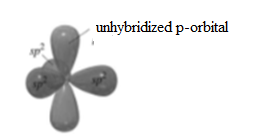
sp3-hybridization: It is formed when one s and three p orbital mix with each other in same shell of an atom to produce four new equal orbitals. This hybridization takes place in molecules exhibits tetrahedral geometry. In this hybridization, no p-unhybridized orbital is present as all are hybridized and form four sigma bonds.
Now, for an atom , present in the structure compound, the sum of the number of bonded an atom s and number of lone pairs present on it results its steric number. The value of steric number tells about the hybridization of central an atom.
| Steric Number | Hybridization | Structure |
| 2 | sp | Linear |
| 3 | sp2 | Trigonal Planar |
| 4 | sp3 | Tetrahedral |
| 5 | sp3d | Trigonal bipyramidal |
| 6 | sp3d2 | Octahedral |
| 7 | sp3d3 | Pentagonal bipyramidal |
In
Number of valence electrons = 5
The expression for calculating number of electron pairs is:
Where, X = number of electron pairs
V = valence electrons of central an atom
M = number of monovalent an atom s
C = charge on compound.
In
Number of lone pairs = 0
Steric number 5 shows that the hybridization of central an atom is sp3d and geometry is Trigonal bipyramidal.
(a)
Interpretation:
The expected hybridization of the central an atom in
Concept Introduction:
When two atomic orbitals combine with each other to produce hybrid orbitals, redistribution of energy of orbitals of distinct an atom s to form orbitals with equal energy occurs. This process is known as hybridization and the formed new orbitals are known as hybrid orbitals.
(a)
Answer to Problem 20E
The expected hybridization of the central an atom in
Explanation of Solution
On the basis of types of orbitals involved in mixing, different hybridization is classified as sp, sp2, sp3, sp3d, sp3d2, sp3d3.
sp-hybridization: It is formed when one s and one p orbital mix with each other in same shell of an atom to produce two new equal orbitals. This hybridization takes place in linear molecules.
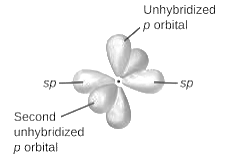
sp2-hybridization: It is formed when one s and two p orbital mix with each other in same shell of an an atom to produce three new equal orbitals. This hybridization takes place in molecules exhibits trigonal planar geometry.

sp3-hybridization: It is formed when one s and three p orbital mix with each other in same shell of an atom to produce four new equal orbitals. This hybridization takes place in molecules exhibits tetrahedral geometry. In this hybridization, no p-unhybridized orbital is present as all are hybridized and form four sigma bonds.
Now, for an atom , present in the structure compound, the sum of the number of bonded an atom s and number of lone pairs present on it results its steric number. The value of steric number tells about the hybridization of central an atom .
| Steric Number | Hybridization | Structure |
| 2 | sp | Linear |
| 3 | sp2 | Trigonal Planar |
| 4 | sp3 | Tetrahedral |
| 5 | sp3d | Trigonal bipyramidal |
| 6 | sp3d2 | Octahedral |
| 7 | sp3d3 | Pentagonal bipyramidal |
In
Number of valence electrons = 7
The expression for calculating number of electron pairs is:
Where, X = number of electron pairs
V = valence electrons of central an atom
M = number of monovalent an atom s
C = charge on compound.
In
Number of lone pairs = 0
Steric number 6 shows that the hybridization of central an atom is sp3d2 and geometry is octahedral.
(b)
Interpretation:
The expected hybridization of the central an atom in
Concept Introduction:
When two atomic orbitals combine with each other to produce hybrid orbitals, redistribution of energy of orbitals of distinct an atom s to form orbitals with equal energy occurs. This process is known as hybridization and the formed new orbitals are known as hybrid orbitals.
(b)
Answer to Problem 20E
The expected hybridization of the central an atom in
Explanation of Solution
On the basis of types of orbitals involved in mixing, different hybridization is classified as sp, sp2, sp3, sp3d, sp3d2, sp3d3.
sp-hybridization: It is formed when one s and one p orbital mix with each other in same shell of an atom to produce two new equal orbitals. This hybridization takes place in linear molecules.

sp2-hybridization: It is formed when one s and two p orbital mix with each other in same shell of an atom to produce three new equal orbitals. This hybridization takes place in molecules exhibits trigonal planar geometry.

sp3-hybridization: It is formed when one s and three p orbital mix with each other in same shell of an atom to produce four new equal orbitals. This hybridization takes place in molecules exhibits tetrahedral geometry. In this hybridization, no p-unhybridized orbital is present as all are hybridized and form four sigma bonds.
Now, for an atom , present in the structure compound, the sum of the number of bonded an atom s and number of lone pairs present on it results its steric number. The value of steric number tells about the hybridization of central an atom .
| Steric Number | Hybridization | Structure |
| 2 | sp | Linear |
| 3 | sp2 | Trigonal Planar |
| 4 | sp3 | Tetrahedral |
| 5 | sp3d | Trigonal bipyramidal |
| 6 | sp3d2 | Octahedral |
| 7 | sp3d3 | Pentagonal bipyramidal |
In
Number of valence electrons = 8
The expression for calculating number of electron pairs is:
Where, X = number of electron pairs
V = valence electrons of central an atom
M = number of monovalent an atom s
C = charge on compound.
In
Number of lone pairs = 0
Steric number 6 shows that the hybridization of central an atom is sp3d2 and geometry is octahedral.
(c)
Interpretation:
The expected hybridization of the central an atom in
Concept Introduction:
When two atomic orbitals combine with each other to produce hybrid orbitals, redistribution of energy of orbitals of distinct an atom s to form orbitals with equal energy occurs. This process is known as hybridization and the formed new orbitals are known as hybrid orbitals.
(c)
Answer to Problem 20E
The expected hybridization of the central an atom in
Explanation of Solution
On the basis of types of orbitals involved in mixing, different hybridization is classified as sp, sp2, sp3, sp3d, sp3d2, sp3d3.
sp-hybridization: It is formed when one s and one p orbital mix with each other in same shell of an an atom to produce two new equal orbitals. This hybridization takes place in linear molecules.
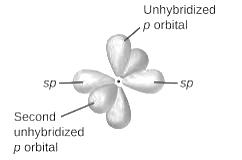
sp2-hybridization: It is formed when one s and two p orbital mix with each other in same shell of an an atom to produce three new equal orbitals. This hybridization takes place in molecules exhibits trigonal planar geometry.
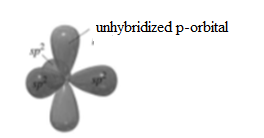
sp3-hybridization: It is formed when one s and three p orbital mix with each other in same shell of an atom to produce four new equal orbitals. This hybridization takes place in molecules exhibits tetrahedral geometry. In this hybridization, no p-unhybridized orbital is present as all are hybridized and form four sigma bonds.
Now, for an atom , present in the structure compound, the sum of the number of bonded an atom s and number of lone pairs present on it results its steric number. The value of steric number tells about the hybridization of central an atom .
| Steric Number | Hybridization | Structure |
| 2 | sp | Linear |
| 3 | sp2 | Trigonal Planar |
| 4 | sp3 | Tetrahedral |
| 5 | sp3d | Trigonal bipyramidal |
| 6 | sp3d2 | Octahedral |
| 7 | sp3d3 | Pentagonal bipyramidal |
In
Number of valence electrons =6
The expression for calculating number of electron pairs is:
Where, X = number of electron pairs
V = valence electrons of central an atom
M = number of monovalent an atom s
C = charge on compound.
In
Number of lone pairs = 0
Steric number 6 shows that the hybridization of central an atom is sp3d2 and geometry is octahedral.
Want to see more full solutions like this?
Chapter 14 Solutions
Chemical Principles
- Can I get helpp drawing my arrowsarrow_forwardWhich of the m/z values corresponds to the base peak in the mass spectrum shown? 100 80 A. 45 B. 44 C. 29 D. 15 Intensity 20 0 10 20 30 40 B- m/z -8 50 E. 30 Which of the m/z values correspond to the molecular ion for the compound shown? A. 18 B. 82 OH C. 100 D. 102 E. 103arrow_forwardCan someone help me with drawing my arrows.arrow_forward
- I'm having trouble with converting lewis diagrams into VSEPR diagrams. I currently have this example of C2BrCl3 which I want to turn into a lewis structure, but I'm not sure what steps I need to do in order to do so. I have the table written down, however, there's two central atoms so what would I do? There seems to be 4 electron domains on the carbon atom and no lone pairs so it would seem like this shape would be tetrahedral. Here's what I have now. Thanks!arrow_forwardWe discussed the solid phase resin using in peptide synthesis. Provide a mechanism, for its formation. DRAW THE MECHANISM.arrow_forwardPlease help. Every time I've asked an expert in the past, it's been wrong :(arrow_forward

 ChemistryChemistryISBN:9781305957404Author:Steven S. Zumdahl, Susan A. Zumdahl, Donald J. DeCostePublisher:Cengage Learning
ChemistryChemistryISBN:9781305957404Author:Steven S. Zumdahl, Susan A. Zumdahl, Donald J. DeCostePublisher:Cengage Learning Chemistry: An Atoms First ApproachChemistryISBN:9781305079243Author:Steven S. Zumdahl, Susan A. ZumdahlPublisher:Cengage Learning
Chemistry: An Atoms First ApproachChemistryISBN:9781305079243Author:Steven S. Zumdahl, Susan A. ZumdahlPublisher:Cengage Learning Chemistry: Principles and PracticeChemistryISBN:9780534420123Author:Daniel L. Reger, Scott R. Goode, David W. Ball, Edward MercerPublisher:Cengage Learning
Chemistry: Principles and PracticeChemistryISBN:9780534420123Author:Daniel L. Reger, Scott R. Goode, David W. Ball, Edward MercerPublisher:Cengage Learning General Chemistry - Standalone book (MindTap Cour...ChemistryISBN:9781305580343Author:Steven D. Gammon, Ebbing, Darrell Ebbing, Steven D., Darrell; Gammon, Darrell Ebbing; Steven D. Gammon, Darrell D.; Gammon, Ebbing; Steven D. Gammon; DarrellPublisher:Cengage Learning
General Chemistry - Standalone book (MindTap Cour...ChemistryISBN:9781305580343Author:Steven D. Gammon, Ebbing, Darrell Ebbing, Steven D., Darrell; Gammon, Darrell Ebbing; Steven D. Gammon, Darrell D.; Gammon, Ebbing; Steven D. Gammon; DarrellPublisher:Cengage Learning Chemistry & Chemical ReactivityChemistryISBN:9781337399074Author:John C. Kotz, Paul M. Treichel, John Townsend, David TreichelPublisher:Cengage Learning
Chemistry & Chemical ReactivityChemistryISBN:9781337399074Author:John C. Kotz, Paul M. Treichel, John Townsend, David TreichelPublisher:Cengage Learning





